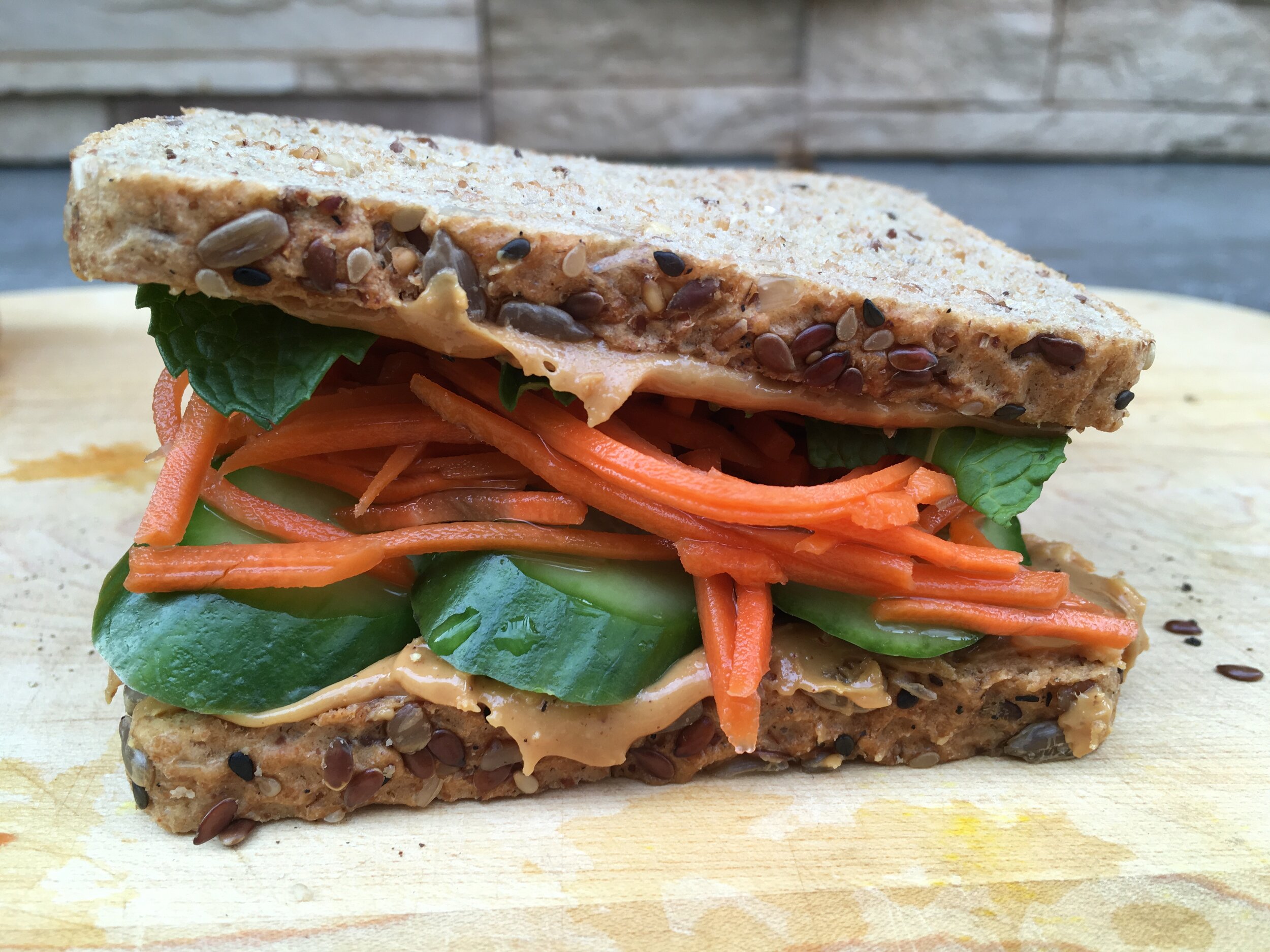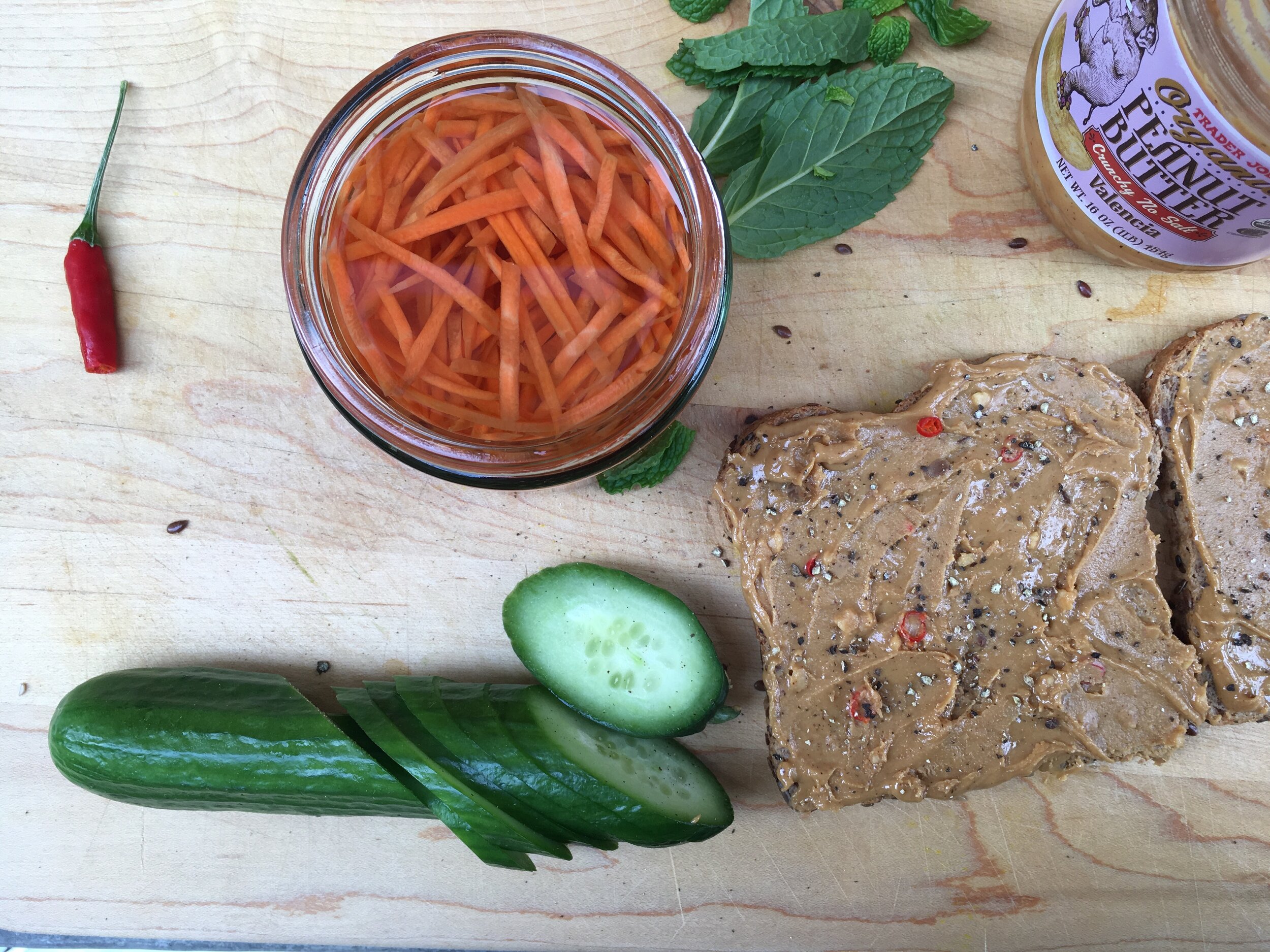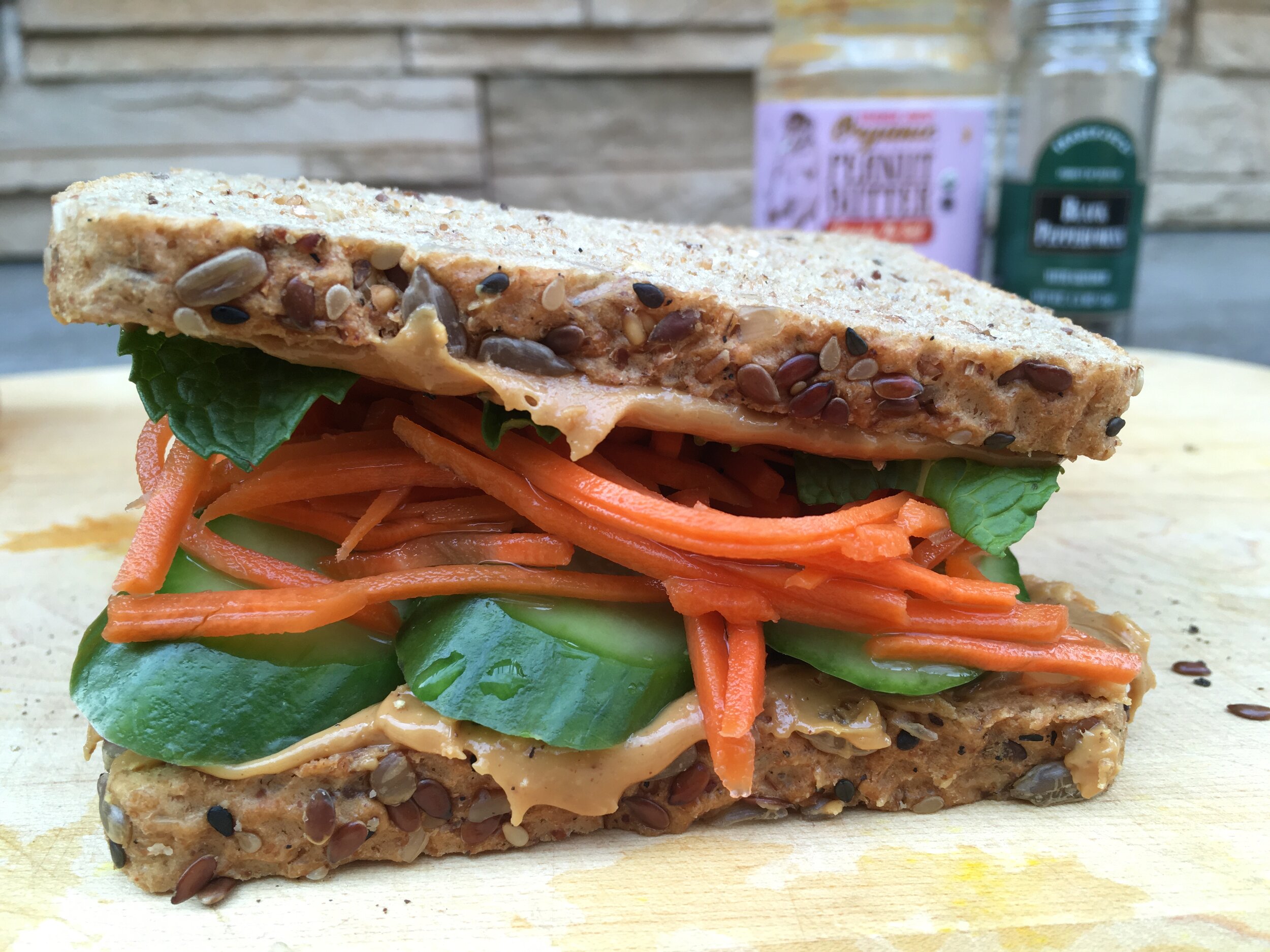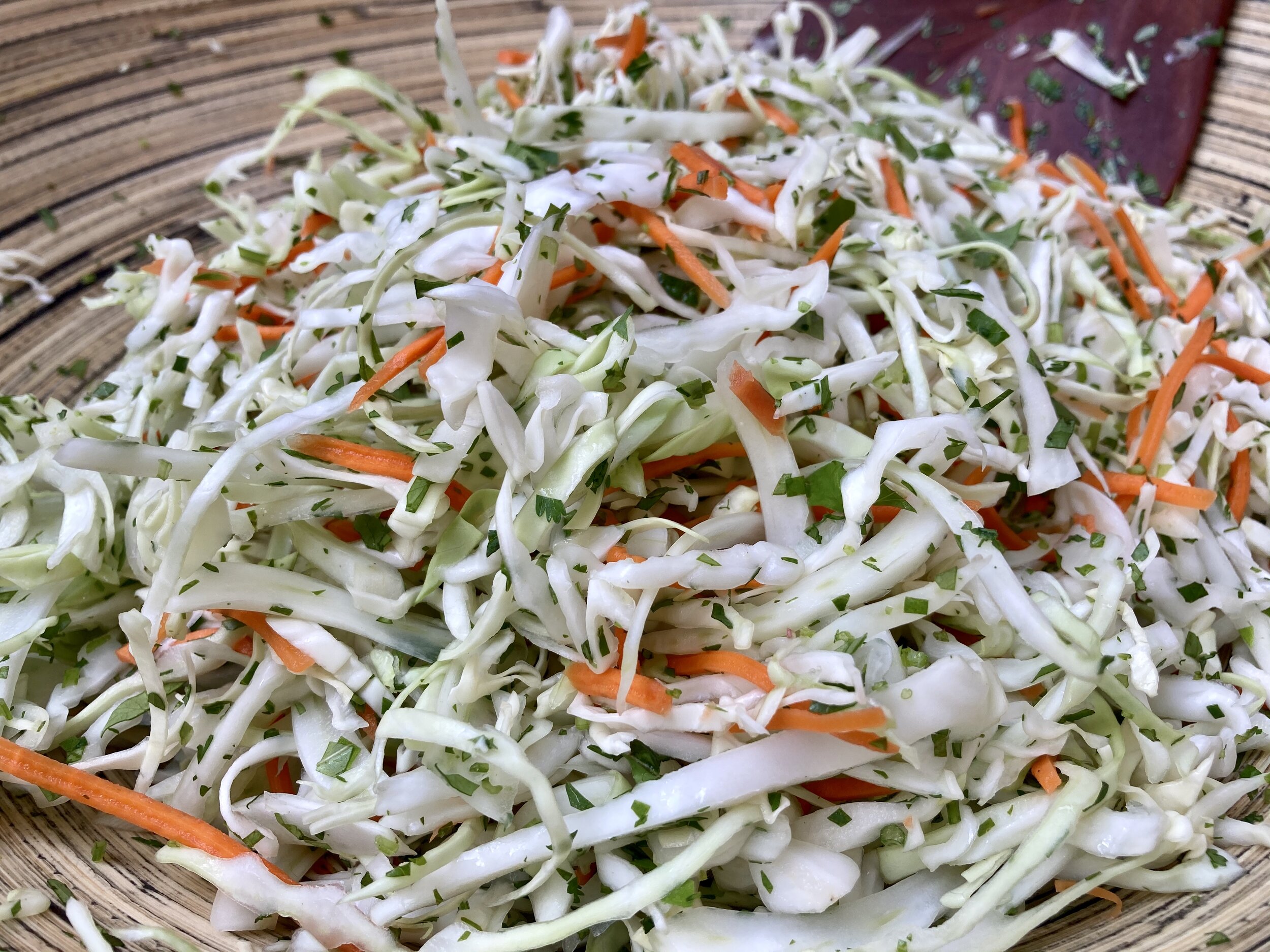The Absolute Best Office Sandwich | Peanut Butter Banh Mi
The Peanut Butter Banh Mi
For me, the best sandwich on earth is a Vietnamese bánh mì.
The rich filling and spreads make a perfect yin-yang balance with crisp, refreshing cucumbers, aromatic fresh herbs, spicy chilies, and sweet pickled carrots and daikon – all bound up together in crunchy-crusted, chewy-crumbed bread. Is there a better sandwich on earth? If so, I haven’t had it yet.
Back when I worked as a lawyer, lunch was the highlight of my workday, even though I almost always ate at my desk. Why? Because my staple lunch was a peanut butter banh mi sandwich.
Imagine: that same holy assemblage of sliced cucumbers, pickled carrots, fresh herbs and chilies, but instead of meat and pâté as the protein, it’s crunchy peanut butter.
The PBBM was the perfect office lunch – created from things I could keep at work for long periods of time: a loaf of sliced sandwich bread and chilies in the freezer, jars of peanut butter and a black pepper grinder in the cabinet, and a reusable container of pickled carrots in the fridge. On good days, I’d bring some fresh cucumber and a handful of fresh herbs from home to dress it up properly. On bad days, I’d just use the office provisions. It never let me down.
Having made and eaten quite a few of these sandwiches over the years, I like to think I’ve achieved the ultimate version. Here’s my six-step program for the perfect office (or shelter-in-place) lunch. (NOTE: There are links in the recipe below to products I recommend. As an Amazon Associate, I may earn a commission (at no additional expense to you) from qualifying purchases.)
Step 1: Gather the Essentials.
The Bread. Vietnam’s banh mi sandwich got its name from the special baguette it is always served on: the part-wheat, part-rice flour bánh mì. So it’s a little blasphemous for me to give you a banh mi recipe that uses American sliced sandwich bread, but it really is better for the job here: it thaws faster, it’s more space-efficient in the freezer, and it gives the optimal ratio of peanut butter to bread.
The Butter. My favorite peanut butter for this recipe is crunchy and salted. I never used to like crunchy peanut butter until this sandwich, but the texture it adds is magic. The salt is also key, since nothing else in the filling is seasoned. Trader Joe’s has a nice organic crunchy salted peanut butter (though somehow I wound up with the unsalted version for the photo). Whole Foods’ 365 Everyday Value also has decent pricing on organic. Use whatever you like, though.
The Spice. For the spicy chili, I like to use a tiny bit of minced birds’ eye or Thai chilies, but those might be too spicy for some people. You could absolutely use jalapeños if you like. If you don’t want to bother with fresh chilies at all, just use your favorite hot sauce or some extra black pepper. TJ’s sells $2 black peppercorn grinders that are perfect for keeping in your desk or kitchen cabinet, because they stand with the grinder side facing up – so they don’t leave a mess like normal pepper mills.
The Pickled Veg. Normally, banh mi sandwiches have a mix of pickled carrots and daikon, but for simplicity’s sake (and laziness – you can’t buy julienned daikon at the store), I go with just carrots. Buy a bag of pre-shredded carrots at the store (once again, Trader Joe’s has what you need, but so do most grocery stores), and give yourself 24 hours to get the pickles pickled.
Fill a tight-sealing storage container of your choice with shredded carrots. Really pack ‘em in tightly, because they shrink up as they pickle. Then pour over a lot of sugar. . . think about one-fourth of the volume of carrots you put in. Whatever you added in sugar, add the same amount of white vinegar. Don’t bother with fancy vinegars here – you want the cheap, plain kind people use for cleaning. It really is the best for the job, trust me. Then, top off the container with enough water to submerge all the carrots. Seal the container and shake it up until the sugar is mostly dissolved, then store it in the fridge.
Generally it takes a day or so for the nice sweet-sour flavor to really come through. Being pickles, these carrots will last for months in the fridge. Once you’ve eaten all the carrots in your container, do NOT throw away the pickling liquid – just refill it with fresh shredded carrots (which also keep a startlingly long time in the refrigerator) and you’ll be back in business 24 hours later. You can do this several times before the liquid gets too dark and weird.
Aside: Besides banh mi sandwiches, you can also use pickled carrots in cabbage salads, green salads, rice or grain bowls, or anytime you want to add a zippy little lift and colorful pop.
The Fresh Veg. The highest and best version of the PBBM combines the tangy crunch of pickled veggies with the crisp, juicy, tenderness of fresh cucumbers and herbs. My go-to choice for the cucumber is the Persian variety, because its skin is thin and soft (thus no need to peel), the flavor is more interesting, and the small size gives you just enough for one sandwich and a few pieces to eat as crudité on the side. (April 2020 update: California’s stay-at-home order revealed to me that well-peeled broccoli stems make a wonderful substitution for the cucumbers here. Seriously, try it.)
For the fresh herbs, use whatever you like (and can get) among the Southeast Asian collection: cilantro, mint, green onions, Thai basil, rau ram (Vietnamese coriander – it’s like cilantro on steroids), or any combination. You need just a sprig or two for the sandwich, but if you like more like I do, go for it!
Step 2: Thaw & Prep. If you have access to an oven or toaster oven, lightly toast the frozen bread. If you don’t, take two pieces of bread out of the freezer in the morning, put them in an airtight container or baggie, and let them thaw on their own until lunchtime.
Slice the cucumber thinly on the bias (so you can cover the bread with fewer slices), and chop whatever amount of chili you want to use. Pluck the herbs off their stems.
Step 3: Slather & Season. This is when you finally get to load as much peanut butter onto your bread as you always wanted to, but never dared. Lay it on thick – this is what will keep you full until evening. I generally use 3-4 Tablespoons split between the two pieces of bread, and spread carefully out to cover every square millimeter of the surface (I hate dry bread in a sandwich). Once the nut butter’s in place, distribute the chopped chilies on one piece of the bread, and season both pieces with freshly ground black pepper.
Step 4: Shingle the Cukes & Herbs. My biggest pet peeve with restaurant sandwiches is uneven filling distribution – you only get a few bites with the advertised filling, and the rest is just empty bread. This banh mi is the opposite of that.
Shingle the cucumber on one piece of the bread, making sure to cover every part of it and press down into the peanut butter. On the other piece, do the same with the herbs. This gives you even distribution of flavor, and helps make sure your filling stays where you put it.
Step 5: Pile on the Pickles. Using a fork (or clean hands), fish out a generous amount of carrots from your pickle jar. Let them drip a few seconds back into the jar, then lay them on top of the cucumber-covered piece of bread and push them around so they’re evenly distributed.
Again, you want some of this in every bite.
Step 6: Top & Chomp. Take the herb-covered piece of bread and use it to close the sandwich. You’ll notice nothing falls off as you do this. The magic of abundant peanut butter!
Press lightly to seal the sandwich, then pick it up with both hands and dig in.
















